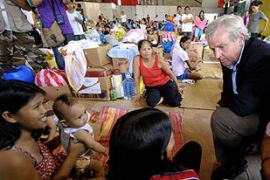Disease fears in Manila flood zone
Flood-hit areas in Philippine capital at risk of disease outbreaks, UN aid chief says.

| FROM THE BLOGS | ||||
|
“People are still living amongst it, wading through it, children are playing in it, which of course raises risks of communicable diseases of a very serious kind,” he said.
In addition he said there were also worries about the impact of the storm on food supplies, with hundreds of acres of farmland and vital rice crops destroyed.
“The government have assures us that they have sufficient food stocks to ensure that food security will not be an issue,” Holmes said.
“On the other hand there’s no doubt that a huge number of farmers – I think 190,000 farmers – have been affected by these typhoons, and rice production will no doubt be affected badly for the next six to nine months.”
Relief and recovery
According to the government, which has ordered an emergency increase in rice imports, the storms destroyed 560,000 tonnes of yet-to-be harvested paddy, or more than eight per cent of the region’s projected fourth quarter production.
| In video |
|
Al Jazeera’s Marga Ortigas reports on continuing flood clean-up efforts |
Two weeks after Typhoon Ketsana, the first of the two storms, hit the country, rescue workers and volunteers are continuing to recover bodies from the debris.
More than 600 people are now known to have died as a result of both Ketsana and tropical storm Parma, which struck the country a week later.
In Manila the heavy rains brought by Ketsana triggered the worst flooding seen in the city in 40 years, causing damage estimated in the hundreds of millions of dollars.
Further north on the main island of Luzon, dozens of landslides triggered by the second storm – Parma – swept away entire villages, killing hundreds of people.
The storm, which roared back and forth across the region for a week, dumped more rain in one day than is usually seen in a month.
Among the worst-hit areas was Baguio city, in the heart of the Cordillera mountain range, where at least 277 people died.
Flooding and mudslides had blocked the main access roads to the area for several days, but at the weekend Chinook helicopters leant by the US military began delivering aid supplies.
